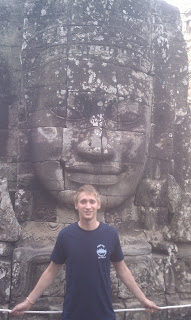On our first trip through Thailand, we skipped Bangkok because our overland visa allowed us only 15 days in country. Our second trip to Thailand we entered by air, which gave us a 30 day visa--plenty of time to see Bangkok and the islands of southern Thailand. From Siem Reap we took a bus back to Phnom Penh where we flew to Bangkok.
Bangkok is the largest city I've been in in Asia, and it has a reputation for some of the worst traffic in the world. Luckily we could get to our hostel from the airport via skytrain and metro (Bangkok has competing urban rail networks, which lack connectivity and don't cover the whole city).
 |
| View of Bangkok from the roof of my 4 story hostel |
 |
| Opposite view |
LUMPHINI PARK
This park lies in the middle of Bangkok's main business district and is one of the most popular parks in the city.
 |
| Clocktower in Lumphini |
 |
| The lake in Lumphini is popular for paddleboating |
 |
| The lake is also popular with the giant lizard community |
THE SUPERBOWL IN BANGKOK
We were in Bangkok for Superbowl Sunday (its Superbowl Monday in Asia). Despite the large American Expat and tourist populations in Bangkok, we had a difficult time finding a sportsbar in town with the game on. The game started at 6 am, but due to slow starts, heavy traffic, and some bad directions, we did not get to the sportsbar until 8.
 |
| The bar could not contain us |
 |
| Giants victory! |
We stayed in Bangkok for a few days before heading off to the southern islands. While we were on the islands we heard that a terrorist attack had taken place down the street from where we watched the superbowl. The three terrorists were Iranian nationals with sights on Israeli targets in Bangkok. On February 14th, the apartment they were using to make bombs exploded and the terrorists attempted to flee the scene. One of them tried to hail a taxi, but when it would not stop he threw a bomb at it. When he was confronted by Thai police he threw a bomb at them. The bomb bounce off a tree back at him, blowing off his legs. Luckily for Israel these terrorists were unsuccessful. Luckily for us at the sportsbar the Iranians hate the Israelis more than they hate Americans.
After two weeks in the islands we returned to Bangkok for a few days. It is our last stop before returning to China.
KHAO SAN ROAD
When we returned to Bangkok we decided to stay a night on Khao San Road. Once a simple Thai rice market, over the past two decades the road has developed into the most notorious 'backpacker ghetto' in Southeast Asia. The street is lined with stores that cater to the budget traveler in Asia: cheap hostels ranging from three star to the roach motel; travel agencies; street food and souvineer venders; and the backpacker bar.
 |
| Khao San Road |
Much of Khao San's popularity with backpackers is its proximity to many of Bangkok's tourist attractions. We were just a short walk from the Democracy Monument, the Giant Swing, and the Grand Palace.
 |
| The Democracy Monument |
 |
| The Giant Swing |
 |
| The Grand Palace |
 |
| Elephants outside the Grand Palace |






















































